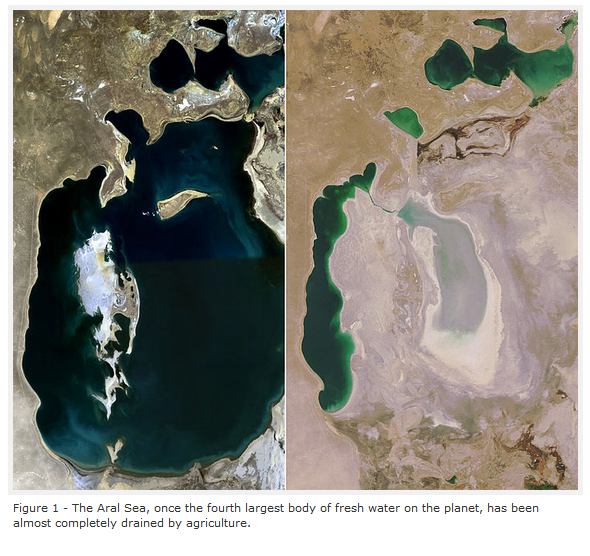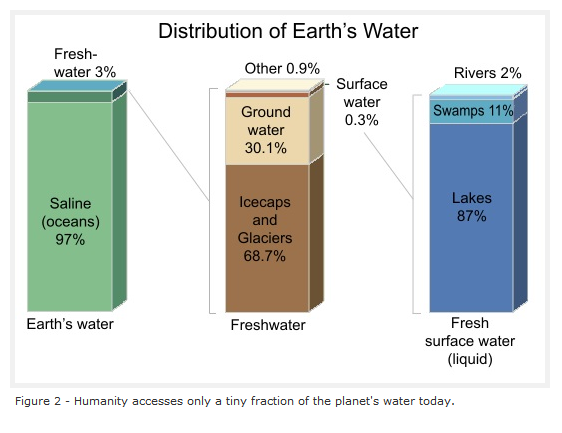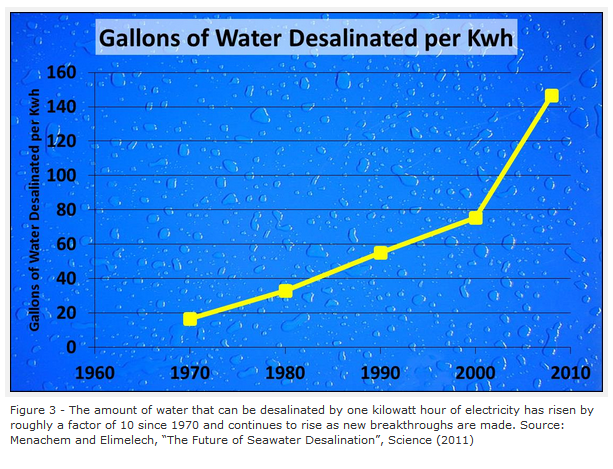 By Ramez Naam
By Ramez Naam
This is Part Three of a five-part series by Ramez Naam, Singularity University Adjunct Faculty, exploring the power of innovation to boost our access to energy, food, water, raw materials, and human population. All are based on his new book, The Infinite Resource: The Power of Ideas on a Finite Planet.
In Part One and Two of this series I showed that we have access to a huge amount of potentially available energy and food on the earth, both stemming from the tremendous input of solar energy to the planet. We have very serious energy and food challenges, which cannot be dismissed. But the challenges are not in the form of a hard limit - they're in the form of a race between innovation and consumption. Victory in this race is certainly not guaranteed. But the most important variable - how quickly we innovate - is one we can affect through our policies. That's a topic we'll return to at the end of this series.
Now let's turn to water.

We live on a water world, yet only a tiny fraction of our precious h2o is fresh water. And around the world, the easy supplies of fresh water are being rapidly depleted.
The Aral Sea, once the fourth largest body of fresh water in the world, is now little more than a dry lake bed. The Ogallala aquifer under the great plains of the United States - an underground body of 'fossil water' deposited during the end of the last ice age more than 10,000 years ago - is seeing its water level drop by three feet a year in some regions. Water tables in Mexico, in Iran, in India, and in China are dropping at rates of 6, 10, or even 20 feet per year.

Rivers that were once mighty are increasingly being overpumped as well. The great Colorado river - which now provides fresh water for 30 million people - runs 130 feet lower than it once did in some areas. And while, for millions of years, the Colorado poured its water into the Gulf of California, those days are passed. Since 1998, the Colorado - like hundreds of rivers around the world now - has simply dwindled into a trickle of water and then nothing but dry caked earth that was once a river bed.
Fresh water depletion may be the most overlooked environmental and natural resource challenge the planet faces. 70% of fresh water is used to grow food. Without that water, agriculture simply doesn't happen.
Yet there may be solutions. While we're exhausting the easily available fresh water in lakes, rivers, and aquifers, there's a far vaster reservoir of water all around us - the salt water in the oceans. The water in those oceans is thousands of times more than humanity uses in a given year. For all effects and purposes, ocean water is a nearly unlimited supply, if we're clever enough and innovate enough to make use of it efficiently.

Desalinating salt water has historically been an environmental nightmare of its own. The process dates back to the ancient Greeks and was largely unchanged from their time until the 1960s: boil water, capture the steam, and let it condense once again into fresh water. That process is incredibly energy intensive, making it both expensive and - since most energy has come from fossil fuels - a source of carbon dioxide emissions.
But that has changed. In the 1970s, researchers took a new approach. In an act of biomimicry, they designed desalination systems modeled after the membranes that surround all living cells. Those membranes can allow water through while stopping salt. The new technique - desalination through semi-permeable membranes - has been improved upon now for decades, and every improvement has increased the ease of desalinating water. A kilowatt hour of electricity can now desalinate around 150 gallons of water, roughly 10 times as much as it could in 1970. And the improvements are continuing.

Even at today's efficiency, desalinated water is still significantly more expensive than water pumped from rivers and aquifers. But if progress in desalination technology can be maintained, that will change over the next few decades. Of course, while most of humanity lives near a body of water, not all of us do. For areas that are deeply inland, desalination may not be an effective option. That said, the same technologies that can efficiently desalinate salt water can also be used to filter and purify waste water, making it much easier to re-use water.
Fresh water access is a very real problem today. But the limit isn't the amount of water on the planet. It's our intelligence. The planet is capable of providing tremendously more water than we need, if we're clever enough. The potential is out there. If we can innovate fast enough in desalination technology, we can tap into it.
Visit XPRIZE at xprize.org, follow us on Facebook, Twitter and Google+, and get our Newsletter to stay informed.
This material published courtesy of Singularity University.